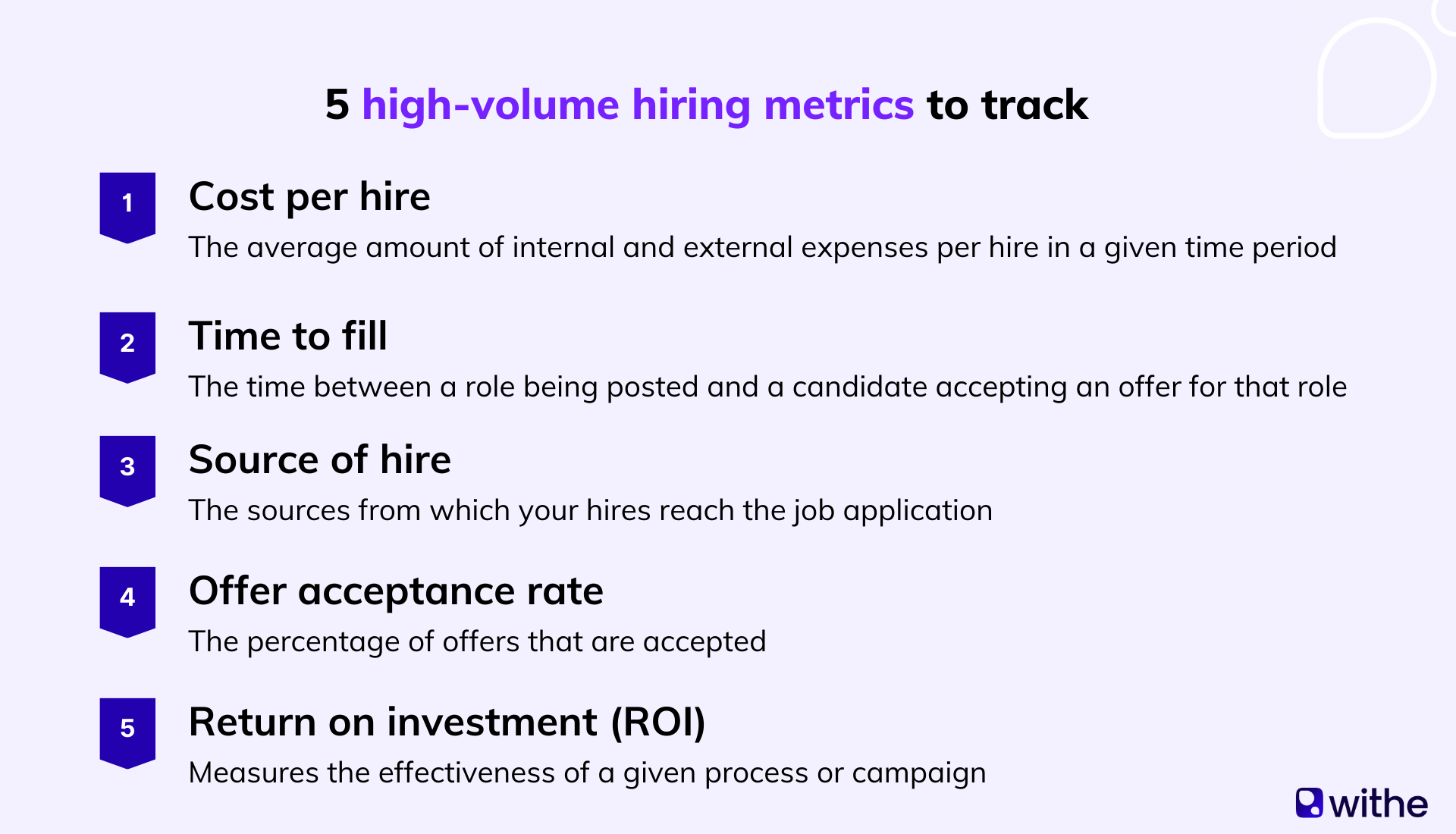Take a close look at any large business and you’ll see that data plays a huge role in defining (and refining) how they operate. Each business function has a set of core metrics that they track to understand what’s working well, what could be better, and whether it’s time to make a big change. This includes recruitment teams that run high-volume hiring processes.
Done right, high-volume hiring should be an efficient process that gets the right people into the right roles as quickly as possible. As such, communication should be timely, processes should be as automated as possible, and there should be minimal time spent between each step in the candidate journey. To make sure your team is running as efficiently and effectively as possible, there are a set of high-volume hiring metrics that you should keep track of. These will help you understand your performance and lead you to data-driven decisions on how to adapt and evolve your processes.
With this in mind, we’ve put together a list of five high-volume hiring metrics with details around what they are, why they’re important, and how to measure them.
1. Cost per hire
What it is: The cost per hire metric tracks how much money and resources are spent to fill each of your open roles.
How to measure it: The average cost per hire is measured by adding all the recruiting expenses in a given period (internal and external) and dividing it by the number of hires made in that same period. These expenses would include advertising costs, recruiter salaries, technology subscriptions, and more.
Why it matters: For high-volume hiring teams, this is a particularly important metric because a high cost per hire can make a significant dent in the overall recruiting budget. Given the sheer volume of roles these teams need to fill, it’s vital to operate with as low a cost per hire as possible.
As you measure this metric, it’s important to set a benchmark that you can compare your performance against on a regular basis. This will help you have a clearer picture of whether you’re operating on budget or not.
2. Time to fill
What it is: Time to fill is a metric that measures the amount of time between a job being posted and a candidate accepting the offer for the role. It evaluates how long a recruiting team spends attracting candidates, evaluating them, conducting interviews, and negotiating an employment contract.
How to measure it: Time to fill is measured by counting the days between the job being posted and an offer being accepted. Teams will also measure the average time to fill for certain teams, time periods, or regions.
Why it matters: Time to fill is a useful metric as it can be used to:
- Measure the efficiency of your team’s recruiting and hiring efforts.
- Indicate potential areas of improvement for your team.
- Identify which types of roles are harder to fill.
- Project the effort or time required to fill future roles.
Note: While time to fill is often used interchangeably with time to hire, these are two different metrics. Time to hire looks more specifically at the candidate journey, measuring the time between a candidate applying for a role and accepting an offer.
3. Source of hire
What it is: The source of hire metric indicates where a hired candidate found the position they were hired for.
How to measure it: Source of hire is measured by having visibility into where the candidate enters the hiring journey from. To track this metric effectively, you’ll need attribution tools that identify where a candidate has arrived from when they fill out an application (e.g. LinkedIn, job boards, a referral, or the career page directly).
From a numerical perspective, you can get a clear picture of the distribution of sources of hire by measuring the percentage of hires that come from each source.
Why it matters: It’s important to understand which sources are most effective for your industry and the types of roles you hire for. With this insight, you can better choose where to invest your time and budget as you seek new hires.
When evaluating your sources, this metric is most useful when analyzed alongside others, like cost per hire. For example, you may get a large number of candidates from one source, but that source is more expensive to manage than others. This will play into the ongoing balancing act of choosing which sources and processes to prioritize as part of your recruitment efforts.
Note: Other useful sourcing metrics include sourcing channel effectiveness and cost per source. These can give a more targeted view of how each source is performing so that your team can decide which source to prioritize.
4. Offer acceptance rate
What it is: The offer acceptance rate metric is used to identify the percentage of job offers a company extends that are accepted by candidates. This metric can be used to understand the acceptance rate across a period of time, for specific job types, or within a given department.
How to measure it: To measure your offer acceptance rate, you take the number of accepted job offers and divide it by the number of offers made. Then you multiply that number by 100.
Why it matters: The offer acceptance rate is useful for identifying what your team is doing right in terms of keeping candidates engaged and effectively communicating expectations. On the flip side, your offer acceptance rate can also help you identify areas of improvement. A poor offer acceptance rate could show that your job offers aren’t competing against your industry peers, that your employer brand isn’t resonating, or that you need to work on improving the candidate experience.
5. Return on investment
What it is: Return on investment (ROI) is a metric that’s used in different ways across different business functions. In simple terms, ROI measures the profitability of an investment. When it comes to high-volume hiring, teams will measure the ROI of their recruiting efforts to determine how effective they are at bringing in new applicants and hires.
How to measure it: You can measure the ROI of your high-volume hiring initiatives by tracking the number of applicants that resulted from a specific campaign. Alternatively, you could track the money or time saved from a new process or campaign, compared to previous attempts.
Why it matters: Tracking your ROI is important because it’s a simple metric that can show business leaders the effectiveness of a specific approach or technology. By tracking it continuously, you can compare different approaches and better assess a new strategy.

High-volume hiring needs to be performance driven
The best high-volume hiring teams are lean and efficient. They fill roles quickly without negatively impacting the candidate experience and leverage tools and processes that help them meet their goals. These teams are also performance driven; they use high-volume hiring metrics to measure how they’re performing and identify potential areas for improvement. It’s this continuous improvement mindset that then helps them stay ahead of their industry peers in what’s an increasingly competitive employer market.
At Withe, we’re helping recruiters improve their high-volume hiring metrics with our on-demand video interview software. Learn more on our homepage.

